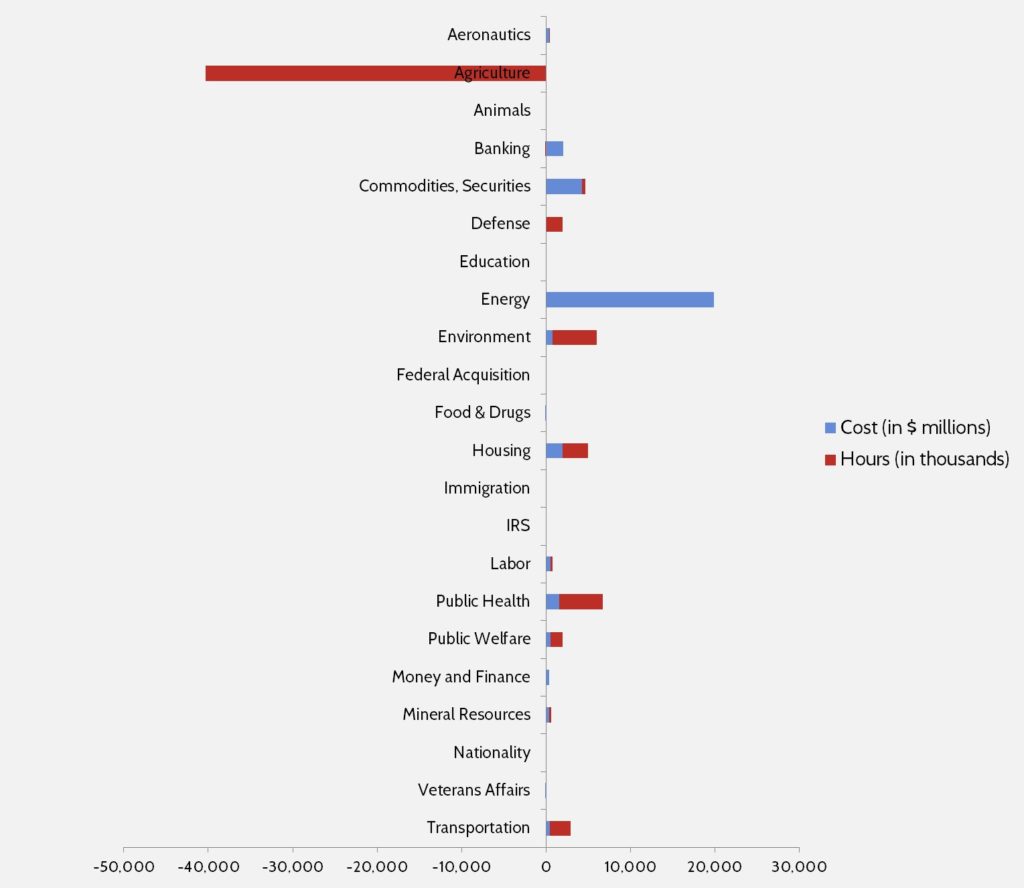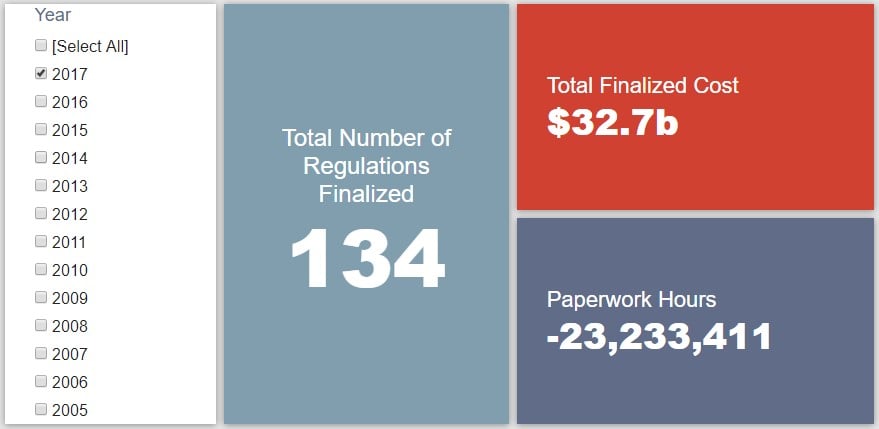Week in Regulation
July 24, 2017
One More Dodd-Frank Rule Finalized
Even as the Trump Administration passes its six-month mark and finally releases its regulatory agenda, a final rule from the 2010 Dodd-Frank financial reform law leads the week in regulation. The Consumer Financial Protection Bureau (CFPB) rule brings nearly $380 million in total costs. Annualized costs (from proposed and final rules) totaled nearly $145 million versus annual benefits of more than $381 million. Agencies also put forward roughly 1 million hours in net paperwork burdens. The per capita regulatory burden for 2017 is $459.
Regulatory Toplines
- New Proposed Rules: 42
- New Final Rules: 61
- 2017 Total Pages of Regulation: 34,188
- 2017 Final Rules: $32.7 Billion
- 2017 Proposed Rules: $114.3 Billion
The American Action Forum (AAF) has catalogued regulations according to their codification in the Code of Federal Regulations (CFR). The CFR is organized into 50 titles, with each title corresponding to an industry or part of government. This snapshot of final rules (a change from earlier versions) will help to determine which sectors of the economy receive the highest number of regulatory actions.
Although not a rulemaking, one of the week’s most notable regulatory developments was the Office of Information and Regulatory Affairs (OIRA) releasing its “Unified Agenda of Regulatory and Deregulatory Actions.” While it is the latest release of its “Spring Version” (since at least 1996), it stands to be an important guide of this administration’s deregulatory plans. For instance, OIRA notes how planned economically significant rulemakings “fell to 58, or about 50 percent less than Fall 2016.” This largely follows the regulatory trends established in the Trump Administration’s first few months.
Another highlight of the week included the Environmental Protection Agency (EPA) publishing its proposed “Renewable Fuel Standard” (RFS) levels for 2018. The proposal could bring cost savings of $70 million compared to the 2017 RFS levels. The proposal also invokes the cellulosic biofuel waiver, allowing it to side-step the statutorily projected level. In a somewhat novel illustrative estimate of cost savings from that action, EPA projects it could save up to $11.8 billion compared to the level potentially set by the underlying statute.
Tracking Regulatory Modernization
While they do not yet count towards the Executive Order (EO) 13,771 tally as they are only proposed rules, a pair of Medicare transfer rules may eventually have implications in that regard. The first proposal brings $101 million in net regulatory costs and even admits that “if finalized as proposed, it is expected to result in regulatory costs,” under EO 13,771. However, its counterpart could bring $16.7 million in cost savings.
On regulatory budget implementation, below are the agencies that have accrued annual savings or new costs under the president’s one-in, two-out budget; proposed rules are not included:
- Defense: -$400 million
- Interior: -$360 million
- Education: -$100 million
- Labor: -$78 million
- Veterans Affairs: -$1.9 million
- HHS: -$8.4 million
- EPA: $60 million
- Energy: $34 million
Many of these figures are the result of CRA resolutions of disapproval. Given their historic regulatory output, AAF can predict that Defense, Interior, and Education will likely meet the goal of $0 in net regulatory costs by the end of this fiscal year.
Affordable Care Act
Since passage, based on total lifetime costs of the regulations, the Affordable Care Act has imposed costs of $53 billion in final state and private-sector burdens and 176.9 million annual paperwork hours.
Dodd-Frank
As noted above, there was a notable final Dodd-Frank rule in the form of CFPB’s rulemaking on “Arbitration Agreements.” The rule seeks “to regulate arbitration agreements in contracts for specified consumer financial product and services.” It would increase costs (mainly legal fees) for certain service providers by roughly $380 million overall. Since CFPB is ostensibly an independent agency, these cost burdens fall outside the scope of EO 13,771. However, lawmakers have already begun the process of seeking to repeal it via a Congressional Review Act resolution of disapproval.
Click here to view the total estimated revised costs from Dodd-Frank; since passage, the legislation has produced more than 74.8 million final paperwork burden hours and imposed $38.9 billion in direct compliance costs.
Total Burdens
Since January 1, the federal government has published $147 billion in compliance costs ($32.7 billion in final rules) and has cut 17.4 million paperwork burden hours (due to 23.2 million in reductions from final rules). Click below for the latest Reg Rodeo findings.












